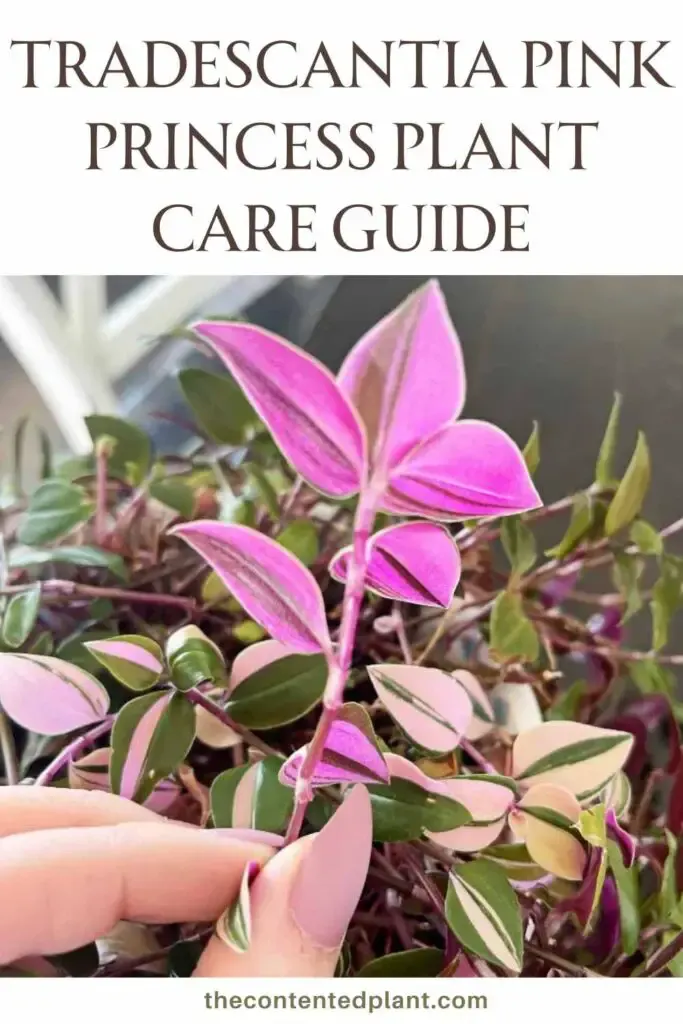Tradescantia Pink Princess is a lovely cultivar of the plant species Tradescantia zebrina. They are commonly known as Wandering Jew ( name quite out of fashion at the moment), or Inch Plant. The name inch plant likely comes from the plant’s growth habit of producing long trailing stems with closely spaced leaves that appear to be about an inch apart from each other, giving the impression that the plant is made up of many small units or “inches.”
It is characterized by its striking pink and green variegated leaves with purple undersides, which are densely covered with tiny silver hairs. This is a fast growing plant and quickly produces lovely cascades of colorful vines.
This plant is a perennial evergreen vine native to Mexico. However tradescantia are wildly popular in all their color forms as houseplants in many parts of the world. It is easy to care for, is quite cheerful and busy. Just the thing to liven up a boring corner in your home.
Zebrina Pink Princess is a fast-growing plant that prefers bright, indirect sunlight and moist, well-draining soil. It should be watered regularly and fertilized every few months during the growing season. Pruning is also recommended to control its growth and maintain its bushy appearance.
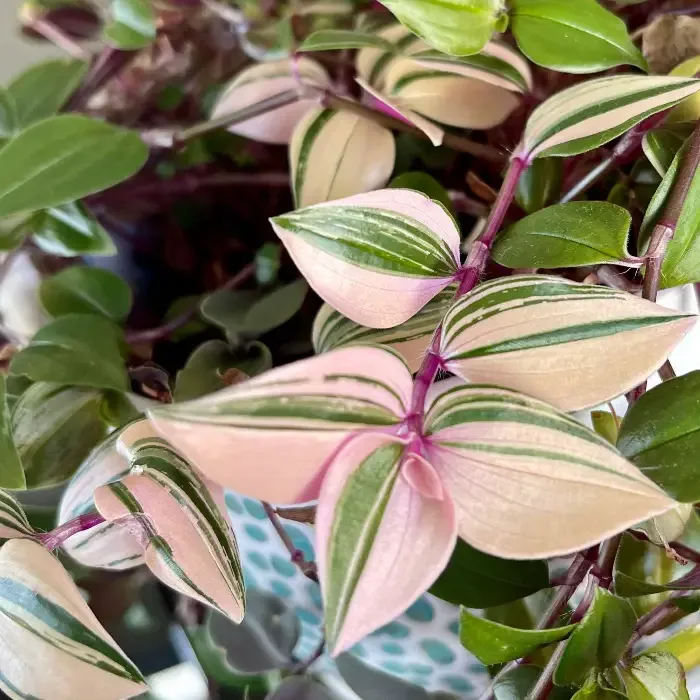
Tradescantia Zebrina is a very well known tried and true houseplant that has been on the market for over 50 years. It is difficult to determine the exact year that Zebrina Pink Princess was first introduced to the market as a cultivar, as plant breeders and nurseries often develop and release new cultivars at different times and in different locations. However, This cultivar has gained popularity in recent years. No wonder. It’s a beauty!
This plant was developed through selective breeding of the Tradescantia zebrina species to produce its distinctive variegated pink and green leaves with purple undersides. Basically the Pink Princess is identical to the zebrina regarding care needs.
Watch our video below on how to properly care for your zebrina.
Growing the Pink Princess as a Patio Plant:
Zebrina Pink Princess can make a beautiful, invigorating and eye-catching addition to a patio or outdoor living space, as long as it is given the right growing conditions and care.
Zebrina Pink Princess can be grown as a patio plant in areas where the temperature does not drop below 55°F (13°C). So this means you can grow it outdoors through the summer in a variety of climate zones. Just remember to bring it in once temperatures decline into the danger zone.
This plant prefers bright, indirect sunlight, so it is best to place it in a location where it can receive filtered light or partial shade, especially during the hottest part of the day.
When growing Zebrina Pink Princess as a patio plant, it is important to ensure that it is planted in well-draining soil and that its container has drainage holes to prevent waterlogging. Regular watering is necessary to keep the soil moist but not waterlogged. Fertilize the plant with a balanced fertilizer every few months during the growing season to promote healthy growth.
Tradescantia Pink Princess vs. Nanouk
In our image compare blow you can see while pink princess and nanouk are similar they do have some quite apparent differences.

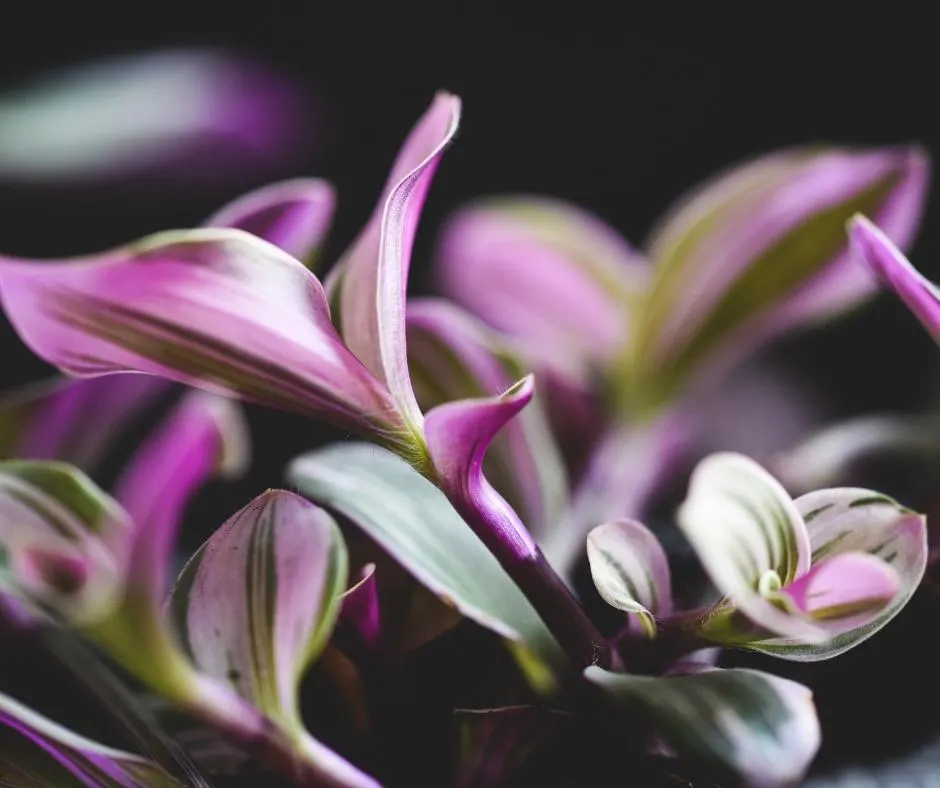
While both Pink Princess and Nanouk are beautiful and easy-to-care-for houseplants, Pink Princess has more striking pink variegation and a trailing growth habit, while Nanouk has a mix of pink, purple, and green leaves and a more upright growth habit.
Pink Princess Tradescantia and Tradescantia Nanouk are both cultivars of the Tradescantia species and have some similarities, but there are also some notable differences between them.
Tradescantia Pink Princess, as the name suggests, is characterized by its pink variegation on green leaves with purple undersides. The leaves are covered in tiny silver hairs, and the plant has a trailing or cascading growth habit. It requires bright, indirect light and consistently moist soil to thrive.
Tradescantia Nanouk, on the other hand, has broader, lance-shaped leaves that are a mix of green, pink, and purple. The leaves are not covered in silver hairs like Pink Princess. Nanouk has a more compact, upright growth habit, and it can tolerate slightly lower light levels than Pink Princess. It also prefers consistently moist soil. Read more on the Nanouk in this post.
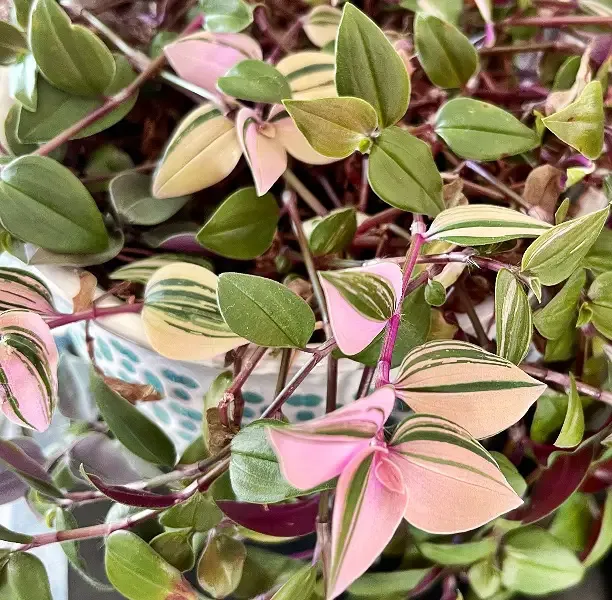
How do you care for Zebrina Pink Princess?
The two most tips we can give you on caring for this plant is correct lighting and watering. I received my pink princess as a gift from my friend. He overwatered it and set it in too low light. Then he gave it to me to save. I’m grateful. I love watching this plant come back and show itself off as it is meant to do.
As you see pictured above, my pink princess zebrina is recovering. It’s starting to show some of its colors now and I’ll soon be pruning off all the reverted green leaves and leaves injured by overwatering.
Zebras can take a lot. But overwatering will kill them and low light forces all variegated plants to revert to green leaves in order to photosynthesize.
Below you will find a quick care and info guide for this plant AND below that is a more detailed care guide to help you get solid on how to make the most of your Pink Princess tradescantia.
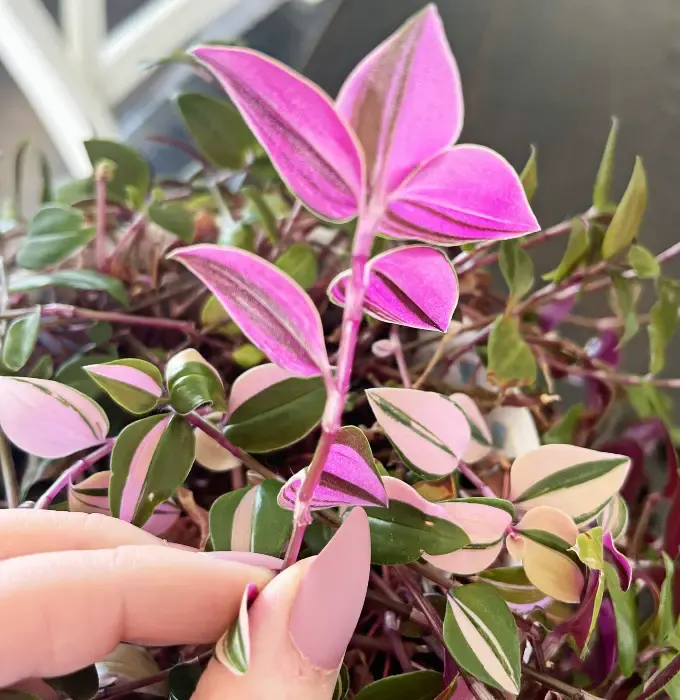
Quick Info and Care tip guide:
| Familiar Names | tradescantia, inch plant, wandering jew(out of fashion), |
| Scientific Name | Tradescantia zebrina ‘Pink Princess’ |
| Plant Family | Commelinaceae family |
| Care Difficulty | easy |
| Temperature | 65 to 85 degrees F. |
| Watering | Keep the soil evenly moist but not too wet. This vine is susceptible to root rot. |
| Humidity | tradescantia pink princess enjoys moderate humidity. If you live in a very dry climate, supplemental humidity is appreciated. |
| Soil | a well-draining soil mix that is rich in organic matter and supplemented with perlite or sand is the best soil type for Tradescantia spathacea ‘Sitara’ or ‘Tricolor’. |
| Fertilizer | Use a balanced (10-10-10) fertilizer. Dilute it to half the recommended strength, and fertilize every two to four weeks during the growing season. |
| Lighting | bright indirect light will give you the best variegation and growth. |
| Growth Habit | This is a hanging vine. This plant is best suited to a hanging basket. |
| Pruning | Pinch the vine back as needed for shaping and length. For a fuller plant prune regularly. |
| Propagation | This vine is best propagated through stem cuttings in either moist soil or water. |
FAQS on This Plant:
Does Tradescantia like the sun? The Tradescantia pink princess enjoys bright INDIRECT sunlight. Strong direct sun rays will cause the leaves to bleach and burn.
Does Tradescantia need a lot of light? It does best in strong indirect light to produce its colors vibrantly. However, this vine will grow well even in lower light. At some degree of loss of light the plant will revert to solid green leaves in order to feed itself and survive.
Is Tradescantia a good houseplant? Zebrina Pink Princess tradescantia is one of the BEST houseplants for beginners and those who tend to neglect their plants but want some color and verve in the house. It’s very undemanding and easy to grow.
For a more in-depth look at the growing requirements of this plant, see our How to Card Below-
Zebrina Pink Princess Care Guide

Tradescantia Zebrina Pink Princessis a beautiful houseplant with cream pink and green striped leaves.
This lovely tri color vine is a perfect beginner houseplant.
Materials
Instructions
Soil Preference:
- This plant requires a light soil.
- A mix of potting soil and perlite will keep the roots happiest.
- Our mix for this plant is 80% potting soil and 20% perlite
- A heavy soil potting mix is not recommended for Tradescantias.
Pot Size and Type:
- Tradescantia vines are quick growing plants, you will need a pot that can accomodate the growth.
- Choose a pot about 2 inches wider in diameter than the current pot.
- Any well drained pot can be used. It MUST have drainage.
- Repot every second year or when roots come out the drainage holes on the pot bottom To the next pot size up.
- Don't jump to a huge pot from a small one unless you wish to encourage faster growth. Just go to the next size up pot.
Lighting:
- The Tradescantia enjoys bright indirect light.
It will tolerate lower indirect light it if has some brighter moments in the day. - The color will fade on this plant if it is not kept in bright indirect light.
- Some filtered sunlight from a window will be appreciated.
- Shield this plant from strong direct light in summer south and west sunny windows. The leaves will burn.
- Tip: Window sheers or blinds can offset some brief periods of high direct light.
Watering:
- Water your Tradescantia Zebrina pink princess when the soil is dry down an inch or so. This plant does not like to dry out too much. Try a watering schedule of every other week.
- Watering is best done on a regular schedule so the plant is not over or under watered. Both can cause stress on the plant.
- This plant enjoys humidity. In dry climates this tradescantia will thrive with a humidifier nearby. or set it in your kitchen or bathroom. For a really dry climate frequent misting will help.
- In dormant winter months reduce watering to when the soil is dry down halfway .
- Never let this plant get wet feet. If the soil is compacted the bottom of the soil can remain wet which encourages root rot and Fungus Gnats. If you see yellow leaves on your tradescantia you are probably overwatering.
How to Fertilize:
- Apply a good quality fertilizer (linked in materials) monthly through Spring and summer.
- Decrease feedings by late Fall and allow your plant to rest through the winter months.
- Look for brown spots on the leaves of your plants. This may indicate an over concentration of salts in the roots from over feeding. It can burn the leaves.
- The remedy is to set the plant under a faucet of water and let the water run through for 10 minutes or so. Allow the pot to Completely drain. Discontinue fertilizer until the plant recovers.
Temperature:
- Keep plant at a low of 65 Degrees F. to upward of 85 Degrees F. It enjoys warmth and humidity.
Pruning and Training:
- Pruning will give you a fuller plant with more even growth. Unpruned vines will trail and get leggy.
- Sharp Hand pruners are preferred for pruning. They will give a clean cut that will heal quickly.
- Tradescantia will naturally trail. They make good hanging baskets or they will happily trail off shelves. For even growth turn hanging pot every time you water.
- Tradescantias will also naturally follow the light. To keep your hanging plant looking balanced around the pot, turn the pot away from the light every lime you water. this will give you a more even plant.
Table Top Plants:
- It’s easy to prune and shape these plants to whatever length and fullness you desire.
- As a table top plant cut the trailers back evenly all around the pot. If you want the pot fuller add more starts.
Pests:
- The Zebrina Pink Princess is not fussy and resists pests. However all plants can get attacked by pests. Read our post and Seven Common Plant pests and How to Kill them.
- Stress by longterm poor watering practices, poor light, extreme temperatures and soil conditions are contributors to stress.
- Spider mites, mealy bugs, scale, thrips and whitefly are the most common houseplant pests you will see.
- Read our post on How to get rid of aphids and other pests with our homemade pesticide soap recipe or neems oil.
- To minimize the possibility of pests be sure to check all nursery plants before bringing them home.
- Quarantine all new plants until you are sure no pests live in them.
How to Propagate:
- Propagation is easily done through leaf node stem cuttings.
- You need a 3 to 6 inch leaf stem with a couple of nodes and healthy growth.
- Place the node into a jar with water. Use tap water that has settled 24 hours in the jar to dissipate chemicals harmful to the plant.
- Set the jar in a well lit area.
- After several weeks roots will grow. Allow the roots to get an inch or more in length.
- Plant gently and firmly into pot with proper soil mix.
- Make sure to keep the soil moist until the roots begin to set into the soil.
Notes
watch our video below for more on Tradescantia care.
Follow Us:
Find us on YouTube, Instagram , Pinterest and TikTok! We love to Plant chat. We also comment, like and occasionally share your content to our daily stories. We’d love to see your plants. Share your joy in your houseplants. Happy Planting!
